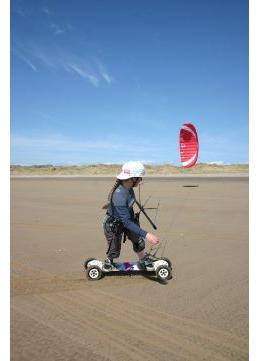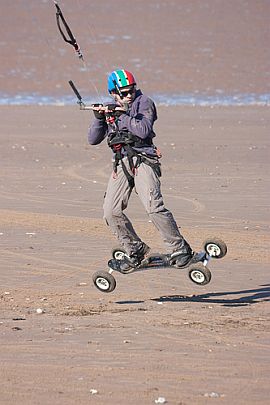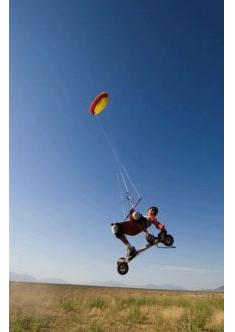- Home Page
- Power Kites
- Landboarding
Landboarding
Skimming Over Dry Flat Ground
Landboarding (or land kiteboarding or even flyboarding to some) is a similar concept to kitesurfing. You just don't get wet, though. ;-)
All it really takes to get into landboarding is some
open space, a traction kite, and a landboard of just about any kind. Oh,
and you need some basic power-kite-flying skills, of course.
The idea is to get the kite overhead first. Then, when you are on your board and ready to roll, the kite is brought down to generate some sideways pull like a sail. With the kite moving in the same direction as the board, you are on your way!
Here are some reasons why newcomers to traction-kite sports might prefer landboarding over kite surfing out on the ocean waves:
- it's a lot easier to learn
- most people get the hang of it in under two hours
- the equipment is cheaper
- you don't have to get wet!
- power-kiting skills can be picked up while you learn
On this site, there's more kite-making info than you can poke a stick at. :-)
Want to know the most convenient way of using it all?
The Big MBK E-book Bundle is a collection of downloads—printable PDF files which provide step-by-step instructions for many kites large and small.
Every kite in every MBK series.
Some Background
Landboarding has been around since the 90s and (like snowkiting) is making use of all the latest traction-kite technology.
The sport involves getting pulled across the ground by a power or traction kite—just like the lady in the pic down there.
There are just so many combinations of these kinds of outdoor sports. If it floats on water, slides on snow, or coasts along on wheels, somebody somewhere has harnessed the power of a kite to add that extra dimension!
 Photo courtesy of Richard Bartlett
Photo courtesy of Richard BartlettHere are all the names you might come across, with regard to kiting with a landboard or other vehicle:
- kiteboarding
- kite landboarding
- land kiteboarding
- fly boarding
- parakarting
- kite buggying
- land surfing
- snowkiting
- kite snowboarding
- kite skiing
- snow-kite skiing
- fly surfing
- kite sailing
- snow kiteboarding
That "land surfing" one gives a clue to as to one big factor that's driving kite boarding. What do surfies do when the water is too cold or there is not enough wind to kitesurf? Many can now hop on a landboard and do much the same sort of stuff, across the sand instead of water.
There's another factor too. What do snow skiers do when the snow melts? Downhill skiers that is, not cross country. For this situation, "mountain boards" were invented, so it was possible to race downhill on these oversized skateboard-like contraptions. Interestingly, in many cases the mountainboarders raced down the very same slopes that they skied down in winter!
Eventually, someone with a traction kite decided to try the obvious. Of course it worked very well, although kite boarding was best done on the flat, rather than a slope. When this got more well known, snow boarders everywhere began to realize they weren't restricted to kite boarding in winter. They could just swap their snowboard for a landboard and still go kiteboarding.
Kite boarding over land tends to attract people who just want to do tricks, or "freestyle", like some kite surfers. That's probably because they are kite surfers first and foremost! There doesn't seem to be much written about landboarders going long distances cross-country like the keenest kite skiers do. Despite this, it is possible to go very fast across land. Also, at the other end of the scale, trundling along slowly in a kite buggy (using a smaller traction kite) can be quite relaxing!
Where to do Landboarding
 Photo courtesy of Nick Hubbard
Photo courtesy of Nick HubbardThe best place to do kite boarding is any large flat area with constant wind and no obstructions. However, with some care, any open space can be used. You just don't want yourself or the kite to crash into anything. In particular, things to avoid include power cables, buildings, and other people.
Here's a summary of the types of areas kite boarders can be seen at:
- parks
- sports fields
- farmers' fields
- large outdoor parking lots
- hard-packed sandy beaches
- school grounds
- dry lake-beds
- if you're fortunate, a nearby dedicated landboarding park!
Here in Australia you could probably add clay pans and salt lakes as well.
Oh, and don't forget airfields and airports, if you can get past the security guys. Just kidding! There's some clips on YT (YouTube) of some Russian guys doing their stuff with large aircraft parked in the background. Now that's actually true!
Talking about YT, here's a clip showing some freestyle kite landboarding in an ideal location that even signposts the activity.
The Scene
Learning
There are three approaches to getting into landboarding:
- Buy some cheap gear and have a go. Be prepared for some interesting experiences. Ouch.
- Check out some instructional videos online, absorb them, then have a go.
- Sign up for a landboarding course and take instruction from a certified power-kiting instructor.
Needless to say, taking a course is expensive but is sure to give a problem-free and safe learning experience.
One kiting school has the following sequence of lessons:
- setting up the equipment—kite, harness, board
- kite skills, particularly the ones involved in moving the board!
- getting on the board, starting, stopping, and getting off again
- having some fun, pulling on as much power as you dare!
Recreation
With learning out of the way, you can head off to the nearest large open area and start covering some ground. A trainer kite with only 2 square meters of area is good to start with. It's nice and safe, although of course you won't get much speed up in most wind conditions.
Later on, you can buy one or two larger kites to enable speedy kiteboarding in a wide range of wind conditions. Just pick the kite that suits the day. That little trainer might come in handy in a gale!
If you're game (and have good basic skills) then you can start to tackle those ramps and grinders that are provided in some of the kite landboarding parks. I can imagine that some parts of the world would be a long, long way from the nearest dedicated landboarding park, though.
Not everyone is dead-keen on doing tricks. For example, there's a few speed freaks out there too. They like to compare each other's GPS-verified top speeds and post them on the Net—like this guy:
Rider: Glen Butcher
Date: 1 Oct 2005
Kite: 7.5 m Frenzy 06
Wind: 24–48 kph (15–30 mph)
Site: Newgale
Board: Quadrolution
Max Speed: 68.9 kph (42.8 mph)
Newgale. That's an interesting name for a windy site. ;-)
Note the speed of nearly 70 kilometers per hour. That's moving, but I guess somebody has beaten it by the time you read this!
Kite Landboarding Competitions
 "Getting some air"
"Getting some air"Do you want to get serious? There is a competition circuit for landboarding, although it is much smaller than for kite surfing and is likely to stay that way for a long time—maybe forever. The kite landboarding comps show off almost everything that you might see competitors doing over water.
Here's a summary of the types of stunts that can be done:
- ramp jumping
- rotations in the air, for example 180 or 360
- flips, both forward and backward
- grabbing the front or rear of the board while airborne
- "board off" moves that involve spinning or flipping the board in the air while the rider's feet are not touching it
- a variety of ground tricks such as sliding, doing "wheelies," or riding facing away from the kite
As you can imagine, getting any of this wrong is likely to hurt more than if it was done over water! So safety gear is very important.
The best riders can put on a decent show using the older-style fixed-bridle kites on handles as well as with the depowerable-kite / control-bar combination that is so popular today.
As mentioned earlier, there's more kite making on this site than you can poke a stick at. :-)
Want to know the most convenient way of using it all?
The Big MBK E-book Bundle is a collection of downloads—printable PDF files that provide step-by-step instructions for many kites large and small.
That's every kite in every MBK series.
